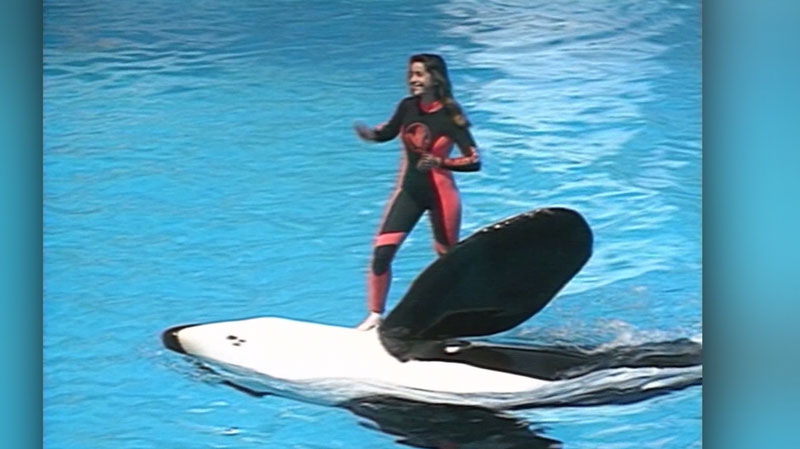SeaWorld Entertainment said Thursday that the killer whales currently living at its facilities will be its last as it will stop breeding them immediately and phase out theatrical orca shows.
The move comes nearly three years after SeaWorld came under pressure for its treatment of killer whales and their trainers in the documentary Blackfish. The company had already announced plans to end killer whale shows at its San Diego park following regulatory scrutiny in California.
SeaWorld will turn its attention to "new, inspiring, natural orca encounters" with educational programs emphasizing enrichment, exercise, and health with its remaining killer whales, CEO Joel Manby said on a conference call.
The orca shows will end in San Diego in 2017, while the San Antonio and Orlando parks will end the shows by 2019.
The company has been under heavy pressure from animal-rights activists, including People for the Ethical Treatment of Animals and other watchdog groups.
"Today marks a bold and impactful shift for our company," Manby said. "The killer whale issue is a growing reason why many people don't visit SeaWorld and this is about doing the best thing for our orcas, our guests, our ambassadors and our company."
The company, which said it has not collected any orcas from the wild in more than 40 years, said its orcas will live out their lives at SeaWorld. That includes one pregnant orca named Takara.
Despite the strategic shift, orcas are likely to live at SeaWorld for many years to come. The average male orca life span is about 30 years, though they can live up to 60, while the average female orca life span is 50 years, and they can live up to 100, according to the National Oceanic and Atmospheric Administration.
But a 1995 study showed that the mortality rate for orcas living in captivity is 2.5 times higher than orcas living in the wild, according to the Animal Welfare Institute.
"They will continue to receive the highest-quality care based on the latest advances in marine veterinary medicine, science, and zoological best practices," SeaWorld said in a statement. "Guests will be able to observe these orcas through the new educational encounters and in viewing areas within the existing habitats."
PETA, which has called for SeaWorld to move its orcas to sanctuaries, hailed the move as a positive step. But PETA senior vice president Lisa Lange called for SeaWorld to send its orcas to "sea pens" located next to the ocean and even release some in the wild, a controversial proposal because captive animals often can't adjust to the wild.
"They should be able to release the animals into more natural settings where they feel the ocean current, the sun on their backs," she said in an interview.
SeaWorld also Thursday announced a new partnership with longtime critic Humane Society of the United States to create educational programs and advocate for the health and welfare of marine life. The company said it would spend $50 million over five years to rescue animals and fight shark-finning and commercial fishing of whales and seals.
"We did not want to be endlessly mired with conflict with SeaWorld. The goal is to make progress for animal welfare," Humane Society of the United States CEO Wayne Pacelle said on a conference call. "In a culture where so many people are deeply concerned with animals, every corporation with animals at the center of its business model must focus on animal welfare. I think it's a great move by SeaWorld."
Animal Welfare Institute marine mammal scientist Naomi Rose said only one captive orca — Keiko, which inspired the 1993 movie Free Willy — has been released to the wild, though he remained dependent on caretakers.
"So I personally believe they all can be retired to sea pen sanctuaries — bigger and more natural spaces," Rose said in an email. "But I do not feel most are candidates for full release. I hope one day SeaWorld will understand that what we are proposing will allow them to continue to care for and, frankly, profit from their orcas and come around to our view."
SeaWorld has been struggling with an image problem and corresponding attendance issues in the wake of Blackfish. The company has turned to discounts to juice attendance and a marketing campaign to restore its image, which has suffered heavy setbacks — particularly in California, where regulators last year blocked the company from breeding orcas.
SeaWorld Chief Financial Officer Peter Crage said the company expects financial benefits from the move based on consumer surveys showing support for the move. Over the next three to five years, the company is projecting an attendance increase of 380,000 to 940,000, revenue uptick of $20 million to $80 million and pretax profit increase of $25 million to $65 million.
The percentage of consumers who would consider visiting SeaWorld after this decision jumped from 5 to 17 percentage points, based on internal polling, Crage said.
After the decision was announced early Thursday, social-media sentiment about SeaWorld turned positive for the first time since Manby joined in March 2015, he said.
"The guests just want to observe and learn, and we don't need these theatrical quote-unquote tricks," Manby said.
SeaWorld shares (SEAS) jumped 9.4% to close at $18.72.
Manby acknowledged that the matter has been controversial internally but expressed hope that the decision would reduce the amount of time the company is spending addressing it.
"I can't tell you how much this orca issue has clouded us from being able to focus on the day-to-day business," he said.
The move marks the latest significant shakeup at SeaWorld since Manby's appointment about a year ago.
Manby recently overhauled his management team, replacing the company's chief parks operations officer, chief zoological officer and San Antonio park director.
The company also last month admitted that some of its employees had posed as animal-rights activists and that it had ended the practice — an acknowledgment that came after PETA last year accused a San Diego park worker spying on its anti-SeaWorld protests.
The company has also faced negative headlines over the bacterial infection in the lungs of Tilikum, the SeaWorld orca whose troubles were chronicled in the documentary.
Follow USA TODAY reporter Nathan Bomey on Twitter @NathanBomey.


